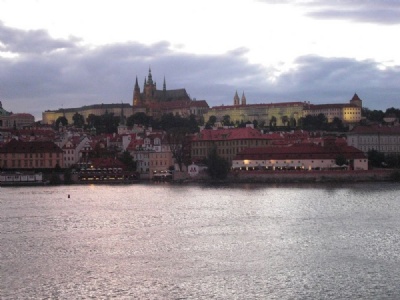Prague Castle
The castle in Prague (or Prague Castle) was built in late 800s and with its approximately 70,000 square meters it’s the largest historical castle in the world. Over the centuries, the castle has been the center of power for Bohemia kings, emperors of the holy Roman empire and leaders of Czechoslovakia and Czech Republic. Over the centuries, the castle has been expanded and renovated according to the wishes and demands of the rulers. When Germany occupied Bohemia and Moravia 15 March, 1939, Hitler visited the city and spent the night at the castle before returning back to Berlin next day. This was the only time Hitler ever visited Prague and Czech Republic. Shortly after Bohemia was occupied, Hitler appointed former foreign minister, Konstantin von Neurath, as Reich Protector of Bohemia-Moravia. The protector was the supreme political leader whose task was to ensure that German policy was implemented in Bohemia.
The office of the Reich Protector were placed in Czernin Palace, east of the castle. Neurath immediately introduced restrictions and regulations according to German model. Although the measures were tight, they were by Nazi standards mild, which meant that the Nazi terror was not unleashed in the same way as elsewhere in Central and Eastern Europe. This was something that came to Hitler’s attention. At the end of September 1941, Hitler appointed Reinhard Heydrich, the second-in-command in SS, as the new Reich Protector. In fact, Heydrich was a deputy to Neurath but was the one with real power. Neurath’s title as a Reich Protector was then only nominal. Heydrich immediately introduced stricter and more brutal methods with great help from Bohemia-Moravia’s Highest SS and Police Leader, Obergruppenführer, Karl Hermann Frank.
Heydrich used both stick and carrot to curb the Czech people. He felt that he had the respect of the Czech people and that they had adapted to the new restrictions. He also felt safe and travelled back and forth between his home in Panenske Brezany and the castle without escort and in an open car when weather allowed. But this overconfidence hit back when he was attacked by two Czech agents on his way to the castle on 27 May 1942. Heydrich was fatally injuried and died about a week later. Heydrich was replaced by Kurt Daluege.
On June 7, Heydrich’s coffin was brought to the castle and displayed on lit de parade. Heydrich was then taken to Berlin for a state funeral, this time with Hitler as one of the funeral guests. The murder of Heydrich also triggered a wave of terror and murder in the Czech Republic where the Germans were determined to set an example. The most famous action is the extermination and massacre of Lidice about twenty kilometres north of Prague.
Current status: Preserved with museum. (2010).
Address: Hradcany, 119 08 Prague 1.
Get there: Metro to Malostranska station.
Follow up in books: Dougherty, Nancy: The Hangman and His Wife: The Life and Death of Reinhard Heydrich (2022).



After the war, the palace regained its former function as a government building and cannot be visited. In front of the palace at Loretan Square is a statue of Edward Benes, president of Czechoslovakia from 1935 to 1938. Benes resisted land cessions to Germany (Suddenland), but was open to certain consessions when pressure from Germany (and Britain and France) increased in 1938. After the Munich agreement in September 1938, when the Sudetenland became German, Benes situation became unsustainable and resigned. The statue’s location infront of Heydrich former office in Prague is probably not an coincidence.